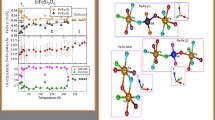Abstract
The (TmxPr1 – x)2Fe17 and (TmxPr1 – x)2Fe16.5Cr0.5 compounds crystallize with the formation of the rhombohedral Th2Zn17-type structure for the compositions with x = 0–0.4 and the hexagonal Th2Ni17-type structure for the compositions with x = 0.8–1 and x = 0.75–1, respectively. Both structures coexist in the (TmxPr1 – x)2Fe17 and (TmxPr1 – x)2Fe16.5Cr0.5 compounds with x = 0.5–0.75 and x = 0.5–0.6, respectively. The (TmxPr1 – x)2Fe17 compositions with 0 < x < 0.6 are ferrimagnets; at x = 0.6–1, additionally a high-temperature helical magnetic state is realized. The substitution of chromium for iron leads to the transformation of the helimagnet to ferrimagnet; in this case, the difference between the Curie temperatures of rhombohedral and hexagonal phases is unexpectedly high (25–28 К). For the composition with x = 0.8, the Curie and Néel temperatures and the ferrimagnet–helimagnet transformation temperature are minimum, and the microdeformations are maximum. The overlap of two peaks in –ΔSM(T), which correspond to the magnetic entropy change at two magnetic phase transformation temperatures, favors the realization of the higher cooling capacity of the two-phase compositions as compared to that of neighboring single-phase compositions.






Similar content being viewed by others
REFERENCES
A. G. Kuchin, W. Iwasieczko, and S. P. Platonov, “The magnetocaloric effect in R2Fe17 intermetallics with different types of magnetic phase transition,” Low Temp. Phys. 41, 985–992 (2015).
D. Givord, R. Lemaire, J. M. Moreau, and E. Roudaut, “X-ray and neutron determination of a so-called Th2Ni17-type structure in the lutetium–iron system,” J. Less-Common Met. 29, 361–369 (1972).
O. Isnard, S. Miraglia, J. L. Soubeyroux, D. Fruchart, and J. Pannetier, “Neutron powder-diffraction study of Pr2Fe17 and Pr2Fe17N2.9,” Phys. Rev. B 45, 2920–2926 (1992).
F. Grandjean, O. Isnard, and G. J. Long, “Magnetic and Mössbauer spectral evidence for the suppression of the magnetic spin reorientation in Tm2Fe17 by deuterium,” Phys. Rev. B 65, 064429 (2002).
A. G. Kuchin, S. P. Platonov, A. V. Korolyov, A. S. Volegov, V. I. Voronin, I. F. Berger, L. V. Elokhina, G. M. Makarova, and E. V. Belozerov, “Magnetism and structure of near-stoichiometric Tm2Fe17 + δ compounds,” J. Alloys Compd. 599, 26–31 (2014).
A. G. Kuchin, S. P. Platonov, V. I. Voronin, W. Iwasieczko, A. V. Korolev, A. S. Volegov, D. S. Neznakhin, A. V. Protasov, I. F. Berger, D. A. Kolodkin, and N. V. Proskurnina, “Influence of microdeformations on magnetic phase transitions in the (TmxPr1 – x)2Fe17 system,” J. Alloys Compd. 726, 330–337 (2017).
W. C. Oliver and G. M. Pharr, “An improved technique for determining hardness and elastic modulus using load and displacement sensing indentation experiments,” J. Mater. Res. 7, 1564–1583 (1992).
D. Givord and R. Lemaire, “Magnetic transition and anomalous thermal expansion in R2Fe17 compounds,” IEEE Trans. Magn. 10, 109–113 (1974).
Y. G. Xiao, G. H. Rao, Q. Zhang, G. Y. Liu, Y. Zhang, and J. K. Liang, “Influence of rare earth mixing on structural and magnetic properties of Nd2 – xErxFe17 compounds,” J. Alloys Compd. 419, 15–20 (2006).
M. S. Ben Kraiem and A. Cheikhrouhou, “Physical properties study of Nd2 – xGdxFe17 intermetallic alloys,” J. Alloys Compd. 397, 37–41 (2005).
R. Guetari, R. Bez, C. B. Cizmas, N. Mliki, and L. Bessais, “Magnetic properties and magneto-caloric effect in pseudo-binary intermetallic (Pr, Dy)2Fe17,” J. Alloys Compd. 579, 156–159 (2013).
Z. Arnold, A. G. Kuchin, J. Kamarád, and S. P. Platonov, “Unusual stability of ground ferrimagnetic state in Tm2Fe17 under pressure,” J. Met., Mater. Miner. 460, 188–192 (2018).
ACKNOWLEDGMENTS
The study was performed using equipment available in the Magnetometric Center and Division of Mechanical Tests in the Collective Usage Testing Center for Nanotechnologies and Advanced Materials at the Institute of Metal Physics, Ural Branch, Russian Academy of Sciences. We thank A.V. Protasov for the assistance in performing measurements.
Funding
This study was performed in terms of state assignment (themes Magnit, no. АААА-А18-118020290129-5 and Potok no. АААА-А18-118020190112-8).
Author information
Authors and Affiliations
Corresponding author
Additional information
Translated by N. Kolchugina
Rights and permissions
About this article
Cite this article
Kuchin, A.G., Platonov, S.P., Iwasieczko, W. et al. Effect of Chromium Substitution for Iron on the Magnetic and Structural Properties of (TmxPr1– x)2Fe17. Phys. Metals Metallogr. 120, 1137–1144 (2019). https://doi.org/10.1134/S0031918X19100065
Received:
Revised:
Accepted:
Published:
Issue Date:
DOI: https://doi.org/10.1134/S0031918X19100065




